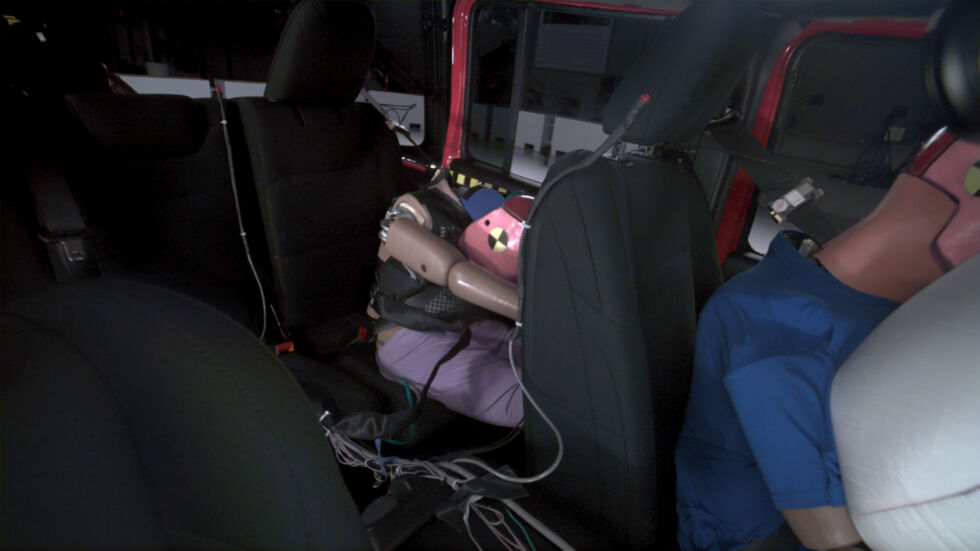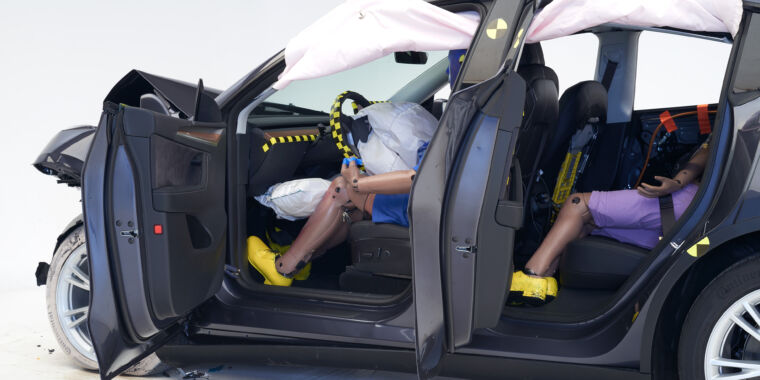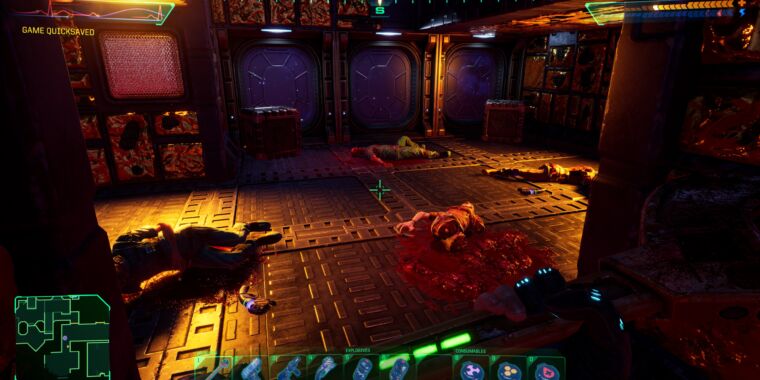
IIHS
Only four of 13 midsize SUVs earned good ratings when it came to protecting rear-seat passengers in an impact, according to new crash tests performed by the Insurance Institute for Highway Safety. Of that 13, two were battery-electric vehicles—the Ford Mustang Mach-E and Tesla Model Y—and both achieved good ratings, as did the Ford Explorer and Subaru Ascent.
The IIHS has been crash-testing cars at its Vehicle Research Center in Virginia since the early 1990s after noticing that most head-on collisions were offset, something the federal government’s crash tests did not account for. Since then, the organization has added several other crash tests that car manufacturers are eager to pass in order to earn a coveted “Top Safety Pick” rating.
The IIHS updated its moderate overlap front crash test in 2022 after becoming frustrated that front-seat safety gains made by the industry have not been shared with those sitting in the back of a car.
In fact, the only federal crash tests that involve a test dummy sitting in the back seat are the Federal Motor Vehicle Safety Standards side-barrier impact test and the closely related New Car Assessment Program side-barrier impact, despite the fact that according to the National Highway Traffic Safety Administration, almost 60 percent of crashes in 2020 were front-impact crashes.

IIHS
The IIHS’s new moderate overlap test now incorporates a 5th-percentile Hybrid III dummy sitting in the second row behind the driver to simulate a small woman or 12-year-old child. The IIHS says that to gain a good rating, the second-row dummy must not register excessive injuries to its head, neck, chest, abdomen, or thighs. The dummies have grease paint applied to their heads to show whether or not the head impacted with the vehicle interior, and the seatbelt must not allow the dummy to “submarine” out from underneath it or cause abdominal injuries. And protecting the rear-seat occupants can’t come at the expense of the driver’s safety.
“Zeroing in on weaknesses in rear-seat safety is an opportunity to make big gains in a short time, since solutions that are already proven to work in the front can successfully be adapted for the rear,” said IIHS Senior Research Engineer Marcy Edwards, who led the development of the updated test. “The four good ratings in this round of testing show that some automakers are already doing it.”
The Ascent, Explorer, Model Y, and Mustang Mach-E each held the rear passenger dummy’s pelvis in place during impact, and the side curtain airbags did their jobs. The IIHS noted a slight risk of head injuries in the Ascent and Explorer and said that in those SUVs and the Model Y, “the rear dummy’s head approached the front seatback, which increases the risk of head injuries.”
Which cars didn’t do so well?
The Chevrolet Traverse, Toyota Highlander, and Volkswagen Atlas each scored marginal ratings for rear-seat protection. The IIHS says there was a slight risk of head or neck injuries in the Highlander and Atlas and a more significant risk of those injuries in the Traverse. The seatbelt tension was high enough in the Atlas and Traverse to run the risk of chest injuries, and the Highlander’s seatbelt moved from the dummy’s pelvis to its abdomen.
Six of the 13 tested SUVs did not score well at all, earning poor ratings from the IIHS. These were the Honda Pilot, Hyundai Palisade, Jeep Grand Cherokee, Jeep Wrangler 4-door, Mazda CX-9, and Nissan Murano. Some of these vehicles—the CX-9, Grand Cherokee, Murano, Palisade, and Pilot—registered a high risk of head or neck injuries to the rear occupant. The rear seatbelt tension contributed to a high risk of chest injuries in the Grand Cherokee, and the rear dummy’s head ended up between the window and the side-curtain airbag as it rebounded from the initial impact.

IIHS
The Jeep Wrangler showed a significant risk of head and neck injuries to the rear passenger, and during the crash test, the rear seat belt moved from the dummy’s pelvis to its abdomen. The Wrangler also lacks a side-curtain airbag for the rear occupants.
The IIHS says that the crash test data showed that all 13 SUVs protected the driver, although the Atlas crash test showed a significant risk of injury to the driver’s right leg, the Traverse crash saw the driver dummy’s head hit the steering wheel through the airbag, and the Wrangler’s side airbag on the driver’s side did not deploy.
“All these vehicles provide excellent protection for the driver,” said IIHS President David Harkey, “but only a handful extend that level of safety to the back seat.”








